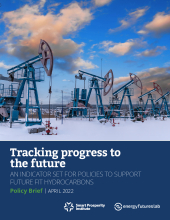Alberta faces the challenge of developing and scaling areas of economic activity that are more competitive in a decarbonizing world. The Energy Futures Policy Collaborative (EFPC), of which Smart Prosperity Institute is a member, has pointed out that Alberta does not need to start from scratch to meet this challenge.
Albertan firms are already exploring opportunities to repurpose assets from the existing hydrocarbon industry to create a cleaner economy. The EFPC has identified these opportunities – which it refers to collectively as “future-fit hydrocarbons” (FFH) – as a means that could advance their ultimate objective of building an economy that supports the well-being of Albertans in a decarbonizing world. As the EFPC has argued, a suite of federal and provincial policies is needed to support investment in FFH industries.
Clear, measurable indicators of success make it easier for policymakers to develop, choose, and implement policies that are aligned with shared objectives. As part of its work with the EFPC, SPI has developed a set of indicators to help policymakers track the success of policies to support investment in FFH industries in Alberta. These indicators align with the criteria for FFH industries identified by EFPC’s expert working groups:
-
Alignment with a net-zero greenhouse gas emissions trajectory
-
Economic viability (including good paying jobs, a healthy balance of payments, resilience to carbon pricing and stranded asset risk, etc.)
-
Building on current strengths through leveraging or repurposing existing assets, which could include infrastructure, workforce skills, intellectual property, or natural resources
-
Alignment of business with environmental, social and governance (ESG) principles
-
Promoting economic reconciliation with Indigenous communities
The indicators outlined in Tracking progress to the future: an indicator set for policies to support future fit hydrocarbons are intended to measure success at the level of either markets for FFH or the entire economy, rather than at the level of individual projects. Some of the indicators measure progress towards ultimate objectives, while others measure the presence of what are understood to be catalysts for this progress, such as the development of low-carbon economic activities. These indicators are intended to be used as a set to identify and implement policies that improve Alberta’s competitiveness in a decarbonizing world while ensuring the wellbeing of all Albertans.






